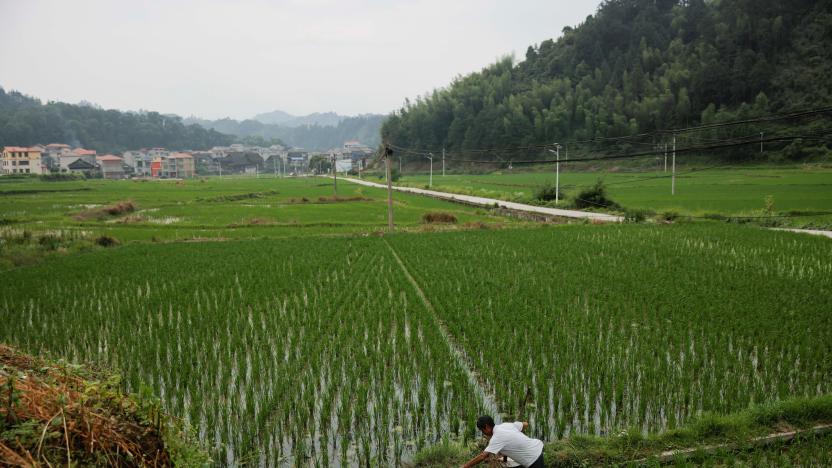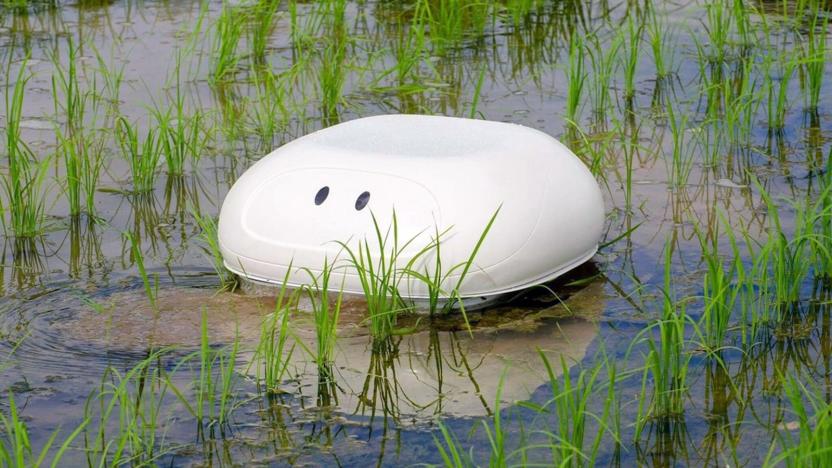rice
Latest

You’ve tried plant-based meat, but here come meat-based plants
Researchers in South Korea injected grains of rice with cow muscle and fat cells to create something being called beef rice. This pink-colored substance could offer a cheaper and more sustainable protein source than standalone meat.

Hitting the Books: 'Miracle Rice' fed China's revolution but endangered its crop diversity
In his new book, Eating to Extinction, BBC food journalist Dan Saladino scours the planet in search of animals, vegetables and legumes most at-risk of extinction, documenting their origins and declines, as well as the efforts being made to restore them.

Robot 'duck' keeps weeds out of rice paddies
For rice farmers, ducks have been a viable way to keep their crops healthy -- they destroy weeds, eat bugs and fertilize crops without using harmful chemicals. And now, a Nissan technician might have an alternative when fowl isn't an option. He's testing a robot 'duck' that roams rice paddies, muddying the water to prevent weeds from getting enough sunlight to grow -- it's really a Roomba (and a cute one at that) for watery fields. Although it's a personal project, it's fully realized with GPS, a WiFi connection and solar power to minimize its environmental impact.

Gene-edited rice plants could boost the world's food supply
Rice may be one of the most plentiful crops on Earth, but there are only so many grains you can naturally obtain from a given plant. Scientists may have a straightforward answer to that problem: edit the plants to make them produce more. They've used CRISPR/Cas9 gene editing to create a rice plant variety that produces 25 to 31 percent more grain per plant in real world tests, or far more than you'd get through natural breeding. The technique "silenced" genes that improve tolerances for threats like drought and salt, but stifle growth. That sounds bad on the surface, but plants frequently have genetic redundancies -- this approach exploited this duplication just enough to provide all of the benefits and none of the drawbacks.

ICYMI: VR Mars bus tour, self-assembling nanowire and more
#fivemin-widget-blogsmith-image-456992{display:none;} .cke_show_borders #fivemin-widget-blogsmith-image-456992, #postcontentcontainer #fivemin-widget-blogsmith-image-456992{width:570px;display:block;} try{document.getElementById("fivemin-widget-blogsmith-image-456992").style.display="none";}catch(e){}Today on In Case You Missed It: Lockheed Martin is encouraging kids to get into STEM with a Mars Experience Bus, with giant displays that look as though they're actually driving on the surface of Mars. Rice University created nanotubes that quickly self-assemble into nanowire. And Yamaha created an acoustic guitar that can store and loop back reverb and chorus sounds. We are also collectively irritated by the latest smart mattress with sensors inside, designed to catch your partner cheating, on your own mattress, when you're not at home. Ugh. As always, please share any great tech or science videos you find by using the #ICYMI hashtag on Twitter for @mskerryd.

Xiaomi's 'Mi Ecosystem' starts with a smart rice cooker
With its air purifiers, water purifiers, security sensors and other home appliances on the Chinese market, it's no secret that Xiaomi has an ambition to not only own the smartphone space, but to also litter its brand around our living space. A bit like Ikea and Muji, for the latter part: Cheap, but with good design and quality. Hence the launch of the Mi Induction Heating Pressure Rice Cooker today, because what better way than to enter every Chinese household with an affordable yet high performance rice cooker, let alone one that works with an app? Priced at just 999 yuan or about $150, this rice cooker is scarily cheap -- about four to five times cheaper than its Japanese rivals like Zojirushi, Toshiba and Tiger.

Modified rice plant produces more grain, less methane
Apparently, the secret to better, more eco-friendly rice plant is another type of grain: barley. A team of scientists has created genetically modified rice that borrows a single gene from barley and found that the altered organism can generate up to 43 percent more grains per plant. Plus, its methane emission is down to 0.3 percent, a lot lower than regular rice's 10 percent emission observed during the scientists' experiments. Methane, as you might know, is one of the most potent greenhouse gases and is the second most prevalent in the US after carbon dioxide.

'3D' white graphene could revolutionize gadget cooling
Graphene seems to be the new millennium's wonder material: it can be used to build more powerful processors, more efficient solar cells, better sounding headphones and, apparently, can even be deep-fried to create long-lasting batteries. Now, researchers at Rice University think that a "3D" variant of the material could change the way we cool our gadgets.

Rice University offers course on Old Norse mythology, Skyrim
Look, you don't need an expensive piece of paper from some institution to know that you're the Dohvakiin. You know it, we know it, the guy you yelled at until he died knows it -- that's all that really matters in the long run. But, if for some reason you did want to expand your knowledge of the ancient legends behind your ancient legend, Rice University has you covered."Scandinavian Fantasy Worlds: Old Norse Sagas and Skyrim" is a new course at Rice University in Houston, TX, which "introduces students to fantasy as both psychological concept and driving force in gamer culture" by having students "read selections from Old Norse and Old Icelandic sagas (in translation) as they play different quests within Skyrim."As you can imagine, enrollment availability is limited to actual, bona fide students at Rice University. Additionally, the class is only available this semester, which is sad considering that beating Skyrim will most likely take longer than passing the course.

Researchers tout efficiency breakthrough with new 'inexact' chip
Accuracy is generally an important consideration in computer chips, but a team of researchers led by Rice University are touting a new "inexact" chip (dubbed PCMOS) that they say could lead to as much as a fifteen-fold increase in efficiency. Their latest work, which won a best paper award at a recent ACM conference, builds on years of research in the field from the university, and is already moving far beyond the lab -- some inexact hardware is being used in the "i-slate" educational tablet developed by the Rice-NTU Institute for Sustainable and Applied Infodynamics, 50,000 of which are expected to wind up in India's Mahabubnagar school district over the next three years. As for the chips themselves, their inexactness comes not just from one process, but a variety of different measures that can be used on their own or together -- including something the researchers describe as "pruning," which eliminate rarely used portions of the chip. All of that naturally comes with some trade-offs (less defined video processing is one example given), but the researchers say those are often outweighed by the benefits -- like cheaper, faster chips that require far less power.

Ditching DRM could reduce piracy, prices, inconvenience
This may run counter to what your common sense tells you but, a new paper out of Duke and Rice University says that ditching DRM could actually reduce piracy. The study, which relied on analytical modeling, showed that while copy protection made illegally sharing content more difficult it had a significantly negative impact on legal users. In fact, the researchers say, "only the legal users pay the price and suffer from the restrictions [of DRM]." Many consumers simply choose to pirate music and movies because doing simple things, like backing up a media collection, is difficult with DRMed content. Even the most effective DRM is eventually broken, and fails to deter those already determined to steal. Meanwhile, abandoning these restrictions could increase competition and drive down prices (as well as remove a serious inconvenience), encouraging more people to legitimately purchase content. You can check out the November-December issue of Marketing Science for more details.

Researchers demo full-duplex wireless: double the throughput with no new towers
Back in February researchers at Stanford first taunted us with the possibility of simultaneous, two-way data transmission on the same frequency. Now some folks at Rice University are edging full-duplex communication closer to reality. By the time carriers get around to rolling out 4.5G networks, engineers could potentially double throughput without adding more cell towers and using only existing mobile hardware. With an extra antenna and some fancy software tricks, which allow the device to ignore locally produced signals, the Rice team was able to produce a connection ten-times stronger than previously published studies. Since the technology is based on existing MIMO setups, it may also prove the shortest route to asynchronous full-duplex transmissions. That means you'll be able to upload ill advised videos of your drunken antics (and suffer the consequences) that much faster, without having to pause the latest Maru clip. Check out the PR after the break. [Image credit: Jeff Fitlow/Rice University]

Rice University chemists bake graphene out of Girl Scout cookies, redefine low-carb diets (video)
Would you like some cookies? Well, you're gonna have to buy them, and then get thee to a Rice University chem lab, stat! The Texas institution of higher learning recently played host to Girl Scouts Troop Beverly Hills 25080, turning their om nom carbohydrated delights into billion dollar graphene. Resident scientist James Tour gathered his gaggle of grad students for a hands-on demo, walking the future Phyllis Neflers through the transformative steps that convert carbon-based material (see: a box of Samoas), into $15 billion worth of scientific loot -- or as one astute troopster put it, "... a lot of cash." Indeed it is young lady, but something tells us your well-earned Science in Action badge won't go too well with those cookie-bought Louboutins. Skip past the break for the full video and a little "Cookie Time" nostalgia.

Students use Wii Balance Board for kids' physical therapy system (video)
Nintendo's kid-tested, researcher-approved Wii Balance Board has struck at the heart of the medical supply industry yet again -- this time, the Bluetooth-connected scale is being used to help physically challenged children at Shriners Hospital in Houston. Seniors at Rice University hand-machined a set of force-sensitive parallel bars and programmed a monster-shooting game called Equilibrium to get kids excited about improving their walking gait, where they can play and score points with each proper step they take. The game automatically ratchets up the difficulty as patients improve, and handrails will play a part too, with a custom three-axis sensor box able to detect how much patients rely on the parallel bars (and dock points accordingly) in an effort to improve their posture. Yep, that sounds just a wee bit more useful than the Balance Board lie detector or the Wii Fit Roomba. Video after the break.

Self-strengthening polymer nanocomposite works best under pressure
No one keeps carbon nanotubes down -- especially not these guys. The always popular allotropes have been enlisted by researchers at Rice University to create a composite material that gets stronger under pressure. When combined with polydimethylsiloxane, a rubbery polymer, the tubes form a nanocomposite that exhibits self-strengthening properties also exhibited in bones. During testing, the team found the material increased in stiffness by 12 percent after 3.5 million compressions. Apparently, the crew is stumped on why it reacts this way, but is no less eager to see it working in the real world -- discussion is already underway to use the stuff as artificial cartilage. And here we thought aerogel was cool. Full PR after the break.

Olympus E-330 shoots vacations by day, spots cancer cells by night
Yeah, that's right -- the first DSLR to ever ship with a live-view LCD on the back is now being put to use for something far more monumental, a full four years after it's original introduction. A smattering of researchers at Rice University have somehow discovered that the Olympus E-330 can be used to distinguish between cancerous and healthy cells, and there's no need to even export the photos; instead, the camera's own rear LCD is good enough to show whether or not a dyed cell is harmful or salubrious. The whole skinny is down there in the source link, but the takeaway is pretty staggering: if an off-the-shelf DSLR can now be used to make such profound decisions, why in the world are you still in med school?

Tokyo robosuit could make you the sack lifting champion
In Japan, the ultimate merit of a robotic suit is measured in sacks of rice. We've seen it before with the HAL-5. The latest suit created by students at Tokyo's University of Science provides enough assistance to the wearer's back to lift an additional 15 to 20 kilograms (that's 33 to 44 pounds) -- in other words, another two bags of rice for five in total. The university's previous robosuit was heavier and more bulky by comparison, in that it provided assistance to both the wearers back and arms (though clearly some support is provided based on the image above). The suit will ultimately benefit factory workers or those with physical limitations when it goes into production sometime in 2010. Outstanding. Surprisingly, nobody from the university seems willing to talk about that kid with sawblade arms in the corner.

Probabilistic logic makes microchip more energy efficient
We'll be straight up with you -- there's a lot of fancy work going on with this one that laypeople will have a tough time grasping, but the long and short of it is this: a team from Rice University (Krishna Palem pictured) and Nanyang Technological University have created a microchip that "uses 30 times less electricity while running seven times faster than today's best technology." Already crying snake oil? Not so fast. By trashing the traditional set of mathematical rules (that'd be Boolean logic) and instead applying probabilistic logic, researchers have figured out how to deliver similar results with a fraction of the energy. The tech is being dubbed PCMOS (probabilistic CMOS), and could eventually end up in embedded systems and even cellphones. In the case of the latter, this type of chip will be able to display streaming video on a minuscule display with more artifacts than usual, but due to the small screen size and the human brain's ability to piece together nearly-perfect images, the errors involved would be all but forgotten. Meanwhile, your battery bar would still be nearly full. We always heard there was beauty in imperfections -- now, at long last, we finally get it.

Rice University rolls out new and improved "nanocar"
Nano-sized letters are one thing, but nothing impresses the nanotechnology community like creepy crawly nanotech, and some researchers from Rice University look to have fully delivered on that point with their latest so-called "nanocar." At about two nanometers in length, the new nanocar apparently doesn't represent a drastic reduction in size over the previous incarnation, but it does have the notable advantage of being able to "travel" across surfaces at room temperature (a temperature of 200° Celsius was required before). Interestingly, that breakthrough was actually discovered by accident, and was later able to be confirmed using a mix of time-lapse photography and a new tracking algorithm. As you might have guessed, however, they're still quite a ways away from being able to actually control the car, although the researchers say using six wheels instead of four could help with that, as could tracks to keep 'em going in one direction.[Via DailyTech]

Murloc bento box looks strangely tasty
A "bento" or "bento box" is a prepared meal in Japanese culture consisting of rice, some kind of meat (often sushi), and cooked vegetables. The big image above is a Murloc bento, put together by a WoW fan with some excellent culinary taste. The Murloc itself is made of cabbage, dyed tofu, and red and yellow pepper stripes, the hut to his left is made of Thai turkey meatballs and steamed cabbage, and the treasure chest is made of tofu and seaweed, while the sun and flowers are eggs.Very interesting. It's still a work-in-progress apparently (though considering that it's all food, it can't take too long to make, can it?), as the creator still wants to get teeth on the Murloc. But it looks pretty ready to eat as is -- the hut and the treasure chest, especially, look pretty delectable. [via PixelatedGeek, thanks, jessE!]












